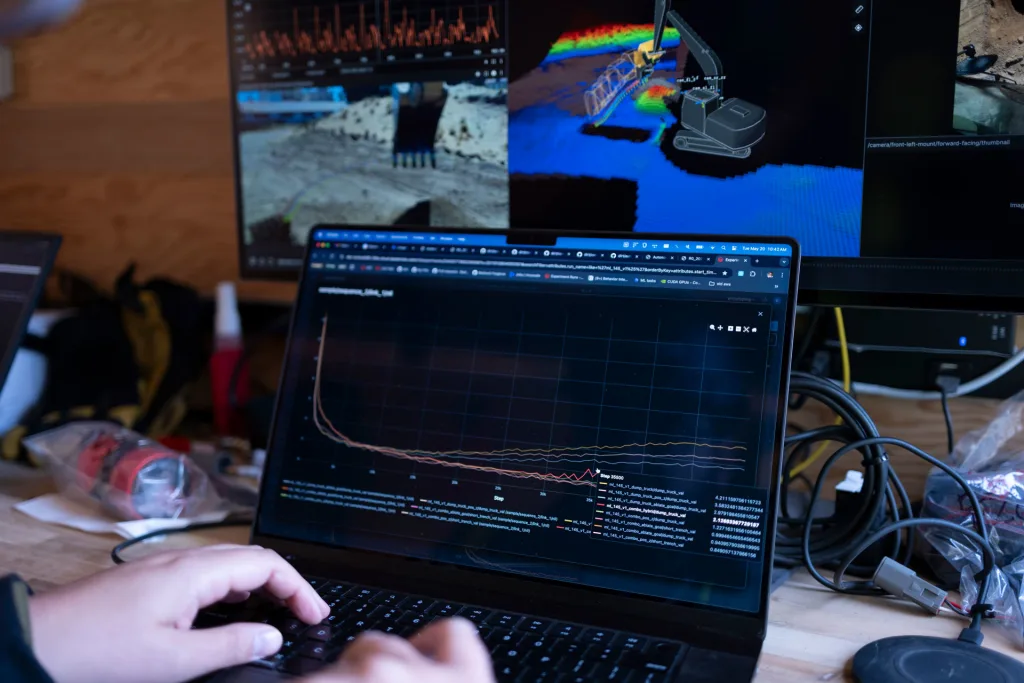America’s demand for new infrastructure is surging, driven by the AI data center boom, clean energy projects, and a growing national housing crunch. Yet just as the country needs to build faster than ever, it’s facing a mounting challenge: a severe construction labor shortage. The U.S. construction industry is already short more than half a million workers, and nearly 41% of its workforce is expected to retire by 2031. For a sector still heavily dependent on manual labor and analog tools, there soon may not be enough people left to do the building.
To confront this growing labor crisis, Boris Sofman—a Carnegie Mellon robotics Ph.D. and early Waymo executive—cofounded Bedrock Robotics in 2024. Instead of building autonomous machines from scratch, Bedrock retrofits existing construction equipment like excavators, bulldozers, and loaders with AI-powered operating systems, sensors, and lidar to make them ">fully autonomous.
Sofman has brought together fellow engineers from Waymo, Google, and Caterpillar (CAT), many of whom were instrumental in scaling autonomous technologies in some of the world’s most complex machines. The team shares a fundamental belief: the future of construction lies in autonomy, not more manpower.
“I saw the powerful potential of applying modern ML approaches we developed at Waymo to construction. This is a problem you could not solve without the modern approaches we saw to be so effective, and helped deploy, in transportation, so it felt like a huge opportunity to address this critical need,” Sofman tells Fast Company. “We can get to a deployed product for a fraction of the cost it took Waymo, and continue to build toward the full potential while growing revenues and serving real customers.”
Based in San Francisco, the startup recently emerged from stealth mode with $80 million in seed and Series A funding from top-tier investors including Eclipse, 8VC, NVIDIA’s NVentures, Valor Equity Partners, Two Sigma Ventures, and Samsara. John Krafcik, former CEO of Waymo, also joined as an early investor and adviser.
“Construction is a sector that represents over 10% of global GDP, and it’s under extraordinary pressure. We’re entering a new phase where industrial AI becomes the most important, and perhaps most underestimated frontier,” Krafcik says. “With Bedrock, I saw a chance to take the best of what we built at Waymo and apply it to one of the most vital yet overstressed sectors in the global economy.”
At the heart of Bedrock’s approach is the Bedrock Operator—an AI-powered software and hardware platform that installs in under four hours and can run 24/7, even in remote or high-heat environments where human crews are difficult to retain.
Bedrock uses large-scale machine learning to translate real-world inputs into precise actions for construction equipment, starting with excavators focused on heavy earthwork. “This is designed to start with an excavator . . . but be efficiently scalable to new capabilities and new machines,” says Sofman.
From Robo-Taxis to Job Sites
Bedrock’s founding team includes Kevin Peterson (CTO), former head of perception for Waymo’s commercial trucking division; Tom Eliaz (VP of engineering), who built Segment’s New York engineering office and worked on IBM’s DB2 query optimizer; and Ajay Gummalla (also a VP of engineering), a former director of engineering at Waymo who also helped launch Google Wifi.
The broader team includes engineers from Uber Freight, Google, and Adept (now OMRON), marketers from Deloitte Consulting, and operators from companies like Sonos. While many startups chase the dream of artificial general intelligence (AGI), Bedrock is laser-focused on industrial autonomy—turning legacy machines into intelligent systems without upending workflows.
“Coupling AI with a modern safety framework based on data analysis and statistics unlocks true autonomy and collaborative machine capabilities in a sector that desperately needs it and is interconnected with our entire economy,” says Matthieu Guilbert, Bedrock’s robotics lead. “This allows robots to work safely and effectively in human-centric environments.”

The upgraded machines feature 360-degree cameras with LiDAR for full-field visibility and detailed work area understanding. “Survey-grade inertial measurement units (IMUs) and GPS provide centimeter-precision localization, while LTE antennas keep worksites connected for real-time monitoring,” explained Sofman. Rugged casings protect components from harsh conditions, while the computing system sits inside the cab, integrating sensor data and executing decisions from a large-scale machine learning model.
With restrictions on foreign labor tightening and infrastructure investment rising—fueled by federal stimulus and AI-driven demand—autonomous construction is becoming not just feasible but necessary.
With rising costs and economic uncertainty, contractors are seeking more predictability on job sites. Bedrock’s autonomous machines offer consistent performance and accurate forecasting. As Sofman puts it, “These machines deliver consistent, predictable output . . . helping accurately forecast project timelines.”
Bedrock’s machines are already running at test sites in California, Texas, Arizona, and Arkansas, in collaboration with firms like Sundt Construction and Zachry Construction. Initial customer deployments are planned for August 2025, with full commercial rollout expected in early 2026.
Is Industrial Autonomy the Real AI Gold Rush?
Bedrock isn’t aiming to eliminate human workers—it’s aiming to ensure they’re no longer the bottleneck. Skilled crews can focus on complex tasks like pipe-laying, while autonomous systems handle repetitive work such as digging, loading, and overnight shifts.
“Automation and robotics are often misunderstood as a zero-sum game. The Bedrock Operator will enhance safety and productivity, fostering growth for team members rather than replacing them, due to its ability to integrate into existing workflows,” says Guilbert. “Increased productivity is expected to encourage general contractors to undertake more projects, resulting in a net increase in labor.”
Given construction’s high accident rates, Sofman believes Bedrock’s Operator can deliver “superhuman safety.” On high-risk or remote job sites, that capability could be transformative. Additionally, the AI provides real-time insights such as project progress, earth volume metrics, and billing data—boosting transparency and speeding up payments.

That pragmatism appeals to investors like John Krafcik.
While AI headlines often focus on AGI, Bedrock’s investors are betting on near-term impact through industrial autonomy. “Where can AI deliver real impact today? Industrial autonomy, especially in construction, is one of those places,” says Krafcik, who praises Bedrock’s unusually deep talent pool from Waymo as “a significant advantage.”
Despite the pace of digital innovation, much of the world still runs on physical industries like construction, agriculture, and logistics. Bedrock is one of the few companies applying autonomy to this economically essential layer. As it approaches commercial launch, it’s positioning autonomy as a pragmatic solution to the modern infrastructure crisis.
Sofman envisions a future where construction is fully digitized and managed by intelligent systems. “Ultimately, this is about digitizing the entire construction process,” he says. The goal? “A general contractor can just define the goal and let the system run.”
Zaloguj się, aby dodać komentarz
Inne posty w tej grupie

It’s been said that online dating killed the meet cute. Now, as people struggle with dating app burnout, some are supposedly resorting to stealing men’s lunches for a chance at creating their own.
An artificial intelligence agenda that started coalescing on the podcasts of

Tesla is likely to post its

A Trenta Starbucks is no longer cutting it. The latest coffee trend has people ordering their iced lattes by the bucket.
Earlier this year, independent coffee shops started going viral


Proton is getting into generative AI with an assistant called Lumo, wh

What happens when you spend decades seeding salacious stories about evil lurking in the halls of power, demanding evidence to prove basic truths, and questioning the veracity of that evidence once
